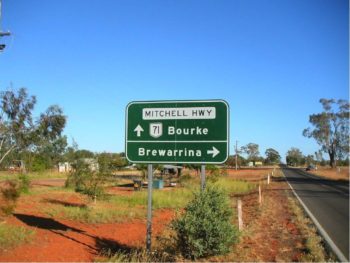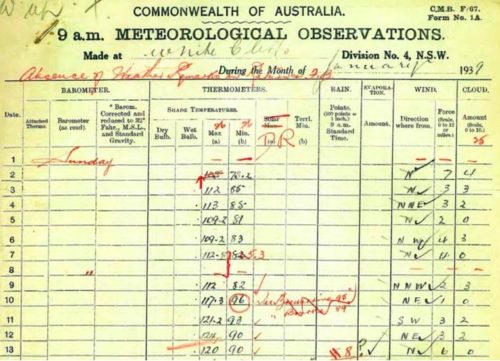
This record* was deleted, falsely claiming that this was likely some sort of ‘observational error’, as no other official weather stations recorded high temperatures on that day.
However, the Liberal Member for Hughes, Craig Kelly, has visited the Australian National Archive at Chester Hill in western Sydney to view very old meteorological observation books.
It has taken Kelly some months to track down this historical evidence. Through access to the archived book for the weather station at Brewarrina, which is the nearest official weather station to Bourke, it can now be confirmed that a temperature of 123°F (50.6°C) was recorded at Brewarrina for January 3, 1909.
This contradicts claims from the Australian Bureau of Meteorology that only Bourke recorded an extraordinarily hot temperature on that day.

Just today, Friday 10th July 2020, Mr. Kelly MP obtained access to this record for Brewarrina, the closest official weather station to the official weather station at Bourke.
He has photographed the relevant page from the book of the observation, and it shows 123°F was recorded at 9.00 am on the morning of Monday, January 4, 1909 – published here for the first time.
This was the highest temperature in the previous 24 hours and corroborates what must now be recognized as the hottest day ever recorded in Australia of 125°F (51.7°C) degrees at Bourke on the afternoon of Sunday, January 4, 1909.


That the Bureau of Meteorology denies these record hot days is a travesty. Is it because these records contradict their belief in catastrophic human-caused global warming?
The temperature of 50.6°C (123°F) recorded back in 1909 which is more than 100 years ago, photographed by Kelly last week at the National Archives in Chester Hill, is almost equivalent to the current official hottest day ever for Australia of 50.7 degrees Celsius at Oodnadatta on 2nd January 1960.
These are in fact only the fourth and third hottest days recorded in Australia, respectively.
Not only has Kelly tracked-down the book of meteorological observations for Brewarrina, but over the last week, he has also uncovered that 51.1°C (124°F) was recorded at White Cliffs for Wednesday, January 11, 1939. This is the second hottest ever!
The evidence, a photograph from the relevant page of the White Cliff’s meteorological observations book, is published here for the first time.

Until Kelly’s efforts, this second hottest-ever record was hidden in undigitised archives.
It is only through his persistence the temperatures at all the official weather stations in the vicinity of Bourke that this and other hot days have been discovered.
If we’re to be honest to our history, then the record hot day at Bourke of 51.7°C (125°F) must be re-instated and, further, the very hot 50.6°C (123°F) recorded for Brewarrina on the same day must be entered into the official databases.
Also, the temperature of 51.1°C (124°F) recorded at White Cliffs on January 12, 1939, must be recognized as the second hottest ever.
For these temperatures to be denied by the Bureau because they occurred in the past, before catastrophic human-caused global warming is thought to have come into effect, is absurd.
At a time in world history when Australians are raising concerns about the Chinese communist party removing books from Libraries in Hong Kong, we should be equally concerned with the Australian Bureau of Meteorology removing temperature records from our history.
If global warming is indeed the greatest moral issue of our time, then every Australian regardless of their politics and their opinion on greenhouse gases and renewable energy must be honest to history and these truths.
- This temperature (125°F/51.7°C on the 3rd January 1909) was recorded at an official Bureau weather station and using a mercury thermometer in a Stevenson screen. Hotter temperatures were recorded in 1896 but the mercury thermometers were not in Stevenson screens, which is considered the standard for housing recording equipment.
Read more at Jennifer Marohasy
Dr. Jennifer Marohasy is a senior fellow at the Institute of Public Affairs.



















Australia has one of the best long-term weather data records to be found anywhere. Or, increasingly, to be found in the garbage bins of history…
Global Warming/Climate Change just a excuse for some like Greenpeace or the NRDC and EDF to make them some quick cash from Hollywood and the suckers who beleive their load of Malarkey
This also explains why the graphs provided by BOM to the ABC start at 1910!
See: https://youtu.be/WppbuIoyXdg
This is in addition to the BOM’s altering of temperatures in the past, and refusing to say how or why.
Yes. But why would BOM delete these records? One suspects an agenda.
“the hottest day ever recorded in Australia, Bourke’s 125°F (51.7°C) on Sunday, January 3, 1909”
An interesting statistic but irrelevant in the antheopigenic global warming (AGW) context. AGW is a theory about a long term rising trend in global mean temperature. There is no interpretation of localized temperature events in this context.
What has temps got to do with pigs? Where did you catch up the word “antheo-pig-enic”?
I think ‘pig-ignorance’ may well be the genesis of that one, Rainer.
But as always they will hide this from the Public these back to nature Eco-Freaks want us all living in fear of a fake Crisis its all the plots of the Globalists to make us surrender our Liberty,Freedom and Soventry to the New World Order and Big Green Brother